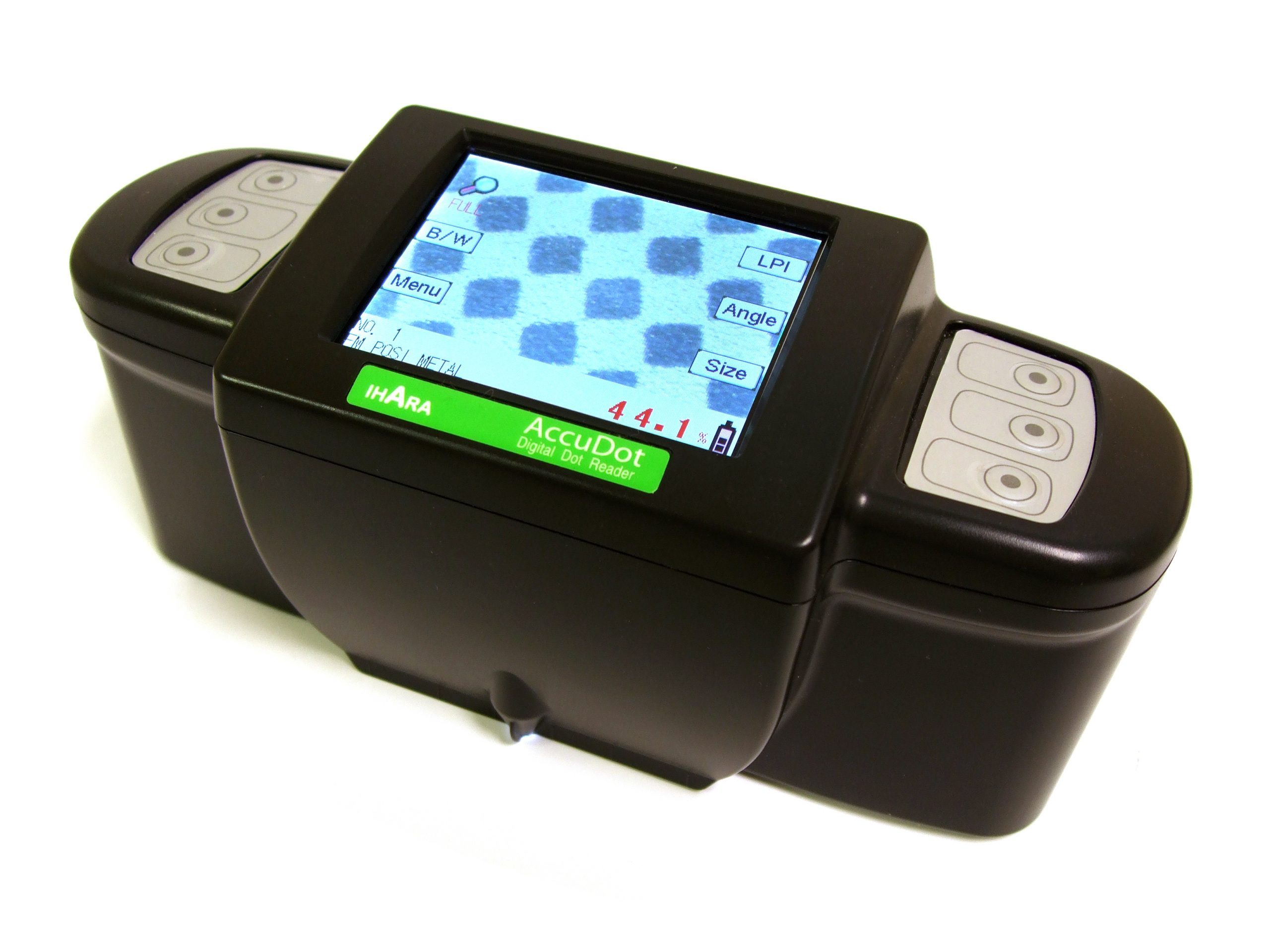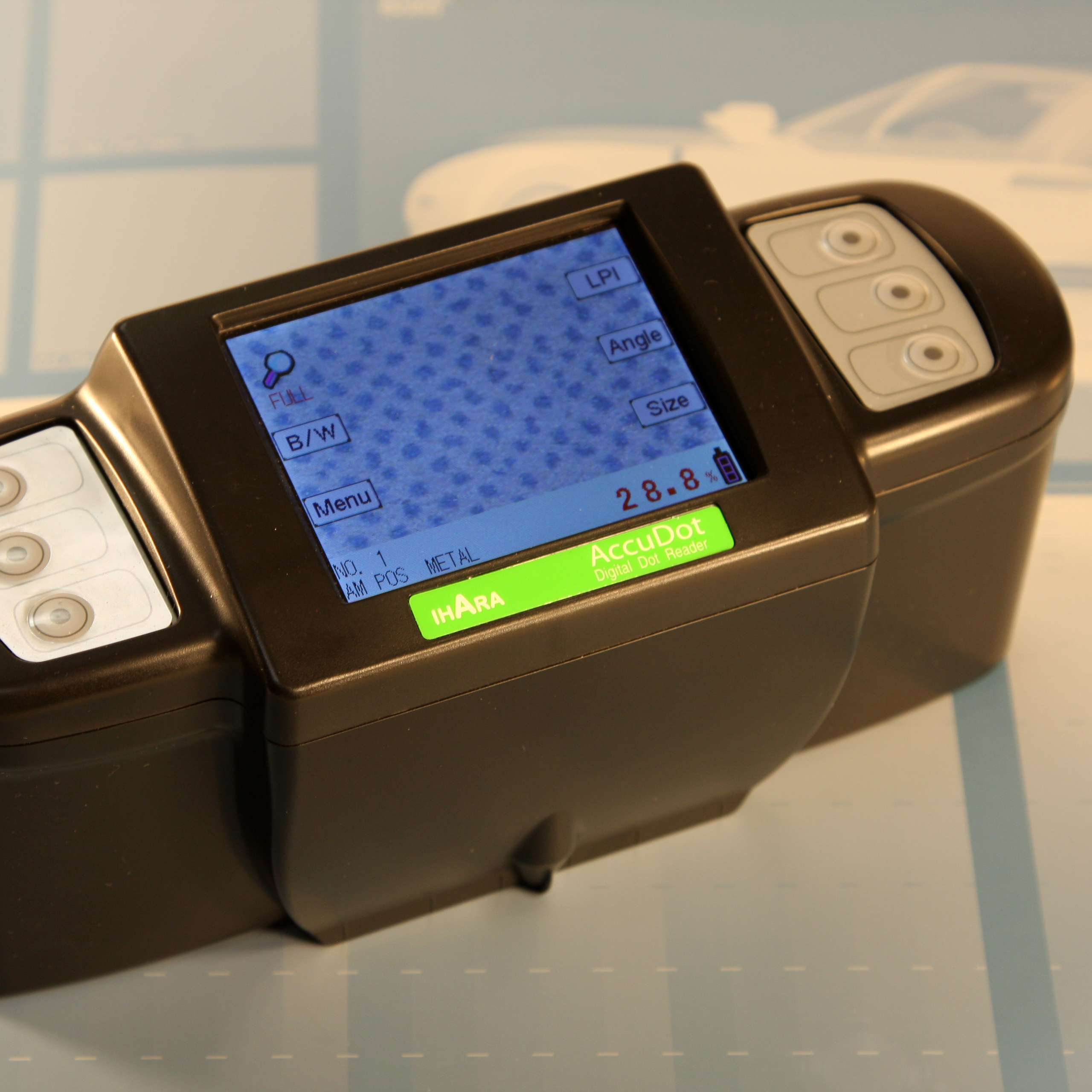AccuDot Digital Plate Reader
Categories
AccuDot Digital Plate Reader
The standalone handheld AccuDot plate reader is the latest innovation from Ihara Electronic Industries (Japan). This high performance plate reader can read all types of plates and screening, including polyester, metal, AM, FM, XM and concentric screening.
AccuDot is available in two models: Basic and Advanced.
Menu-driven Commands:
Simply select the functions desired. No memorization or operation manual required.
Help Key provides explanation of key functions:
Detailed explanations are available for all measurement functions along with answers to frequently asked questions.
Large color LCD display:
The AccuDot has a high resolution color LCD for easy viewing. The high resolution color image enables the operator to detect any anomalies on the plate.
Easy Upgrade:
The AccuDot has a built-in mini-USB connector for easy data communication and upgrade. Firmware upgrade is simply done over the Internet.
Basic / Advanced function comparison chart:
| Function | Basic | Advance |
| Dot % (Plate) | ○ | ○ |
| Dot % (Printed Material) | ○ | ○ |
| Dot% (Film) | ○ | |
| Screen Ruling (LPI, L/Cm) | ○ | |
| Screen Angle | ○ | |
| Memory Image | ○ | |
| Enlarge Image | ○ | |
| Geometric Analysis | ○ | |
| Memory Data | ○ | |
| PC Link | ○ | |
| Dot % Curve Display | ○ |
Features / Measurements
Real-time image display and capture
Reads all plate material
200 memory slots for storing measurement data
Documentation
| Brochure | |
Why use a digital plate reader?
Using a digital plate reader to calibrate the plate processor is invaluable in the offset printing workflow. The plate processor is a crucial part of the prepress stage that develops the offset printing plates, and its proper calibration is essential for achieving consistent and accurate results. Here’s how a digital plate reader can help with the calibration process:
- Measurement of processing parameters: A digital plate reader can measure various processing parameters, such as the developer temperature, developer concentration, and processing time. These parameters play a critical role in determining the quality of the developed plates. By obtaining precise measurements, adjustments can be made to ensure that the processing conditions are within the specified tolerances.
- Detecting processing inconsistencies: The plate reader can identify inconsistencies in the plate processing, which may lead to variations in plate quality. For example, it can detect uneven development, underdeveloped or overdeveloped areas, or insufficient drying. Identifying such issues early on allows for adjustments to be made to the plate processor to maintain consistent plate quality.
- Plate development uniformity: A digital plate reader can assess the uniformity of plate development across the plate surface. It can identify areas with uneven ink receptivity or improper coating, which could lead to printing defects if not corrected.
- Dot gain measurement: Dot gain refers to the increase in the size of printed dots compared to their original size on the plate. A digital plate reader can measure dot gain to ensure that it is within acceptable limits. If dot gain is not controlled, it can affect image sharpness and color accuracy in the final printed product.
- Process optimization: The data collected by the plate reader during calibration can be used to optimize the plate processor’s settings and fine-tune the processing conditions. This optimization process aims to achieve the best possible plate quality and print performance.
- Documentation and traceability: A digital plate reader provides a record of the calibration process and the measurements taken. This documentation is valuable for quality control purposes and helps ensure traceability in case of any issues or deviations in the future.
By using a digital plate reader to calibrate the plate processor, printing companies can maintain consistency in plate quality, improve print accuracy, reduce waste, and ensure that the printing plates meet the required standards for high-quality offset printing.
Product Specifications
- Measurement Functions
- Dot% (0-100%), Screen Ruling (LPI, LPC), Screen Angle
- Measurement Media
- Plate (Pos / Neg Reading), Printed Copy (CMYK Dot%) (AM: 65lpi – 300lpi)(FM: 10μm~50μm)
- Light Source
- White LED
- Image Sensor
- Color Image Sensor
- Target Size
- Approx. φ1.0
- Repeatability
- ±0.5%
- Measurement Time
- Approx. 2 sec.
- Inter-instrument Agreement
- ±0.5%
- Data Storage
- 320×240 Color (262,144 color)
- Display
- 200 data
- Power Supply
- Li-ion Battery
- Computer Output
- USB
- Dimensions / Weight
- 200(L)×93(D)×73mm(H) / Approx. 500g (With Batteries)
- Operating Temperature Range
- 41F – 104F (5~40℃)
- Accessories
- AC Adapter / Operation Manual / USB Cable / IP65 Rated Heavy Duty Carrying Case






